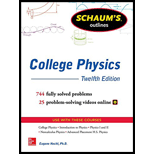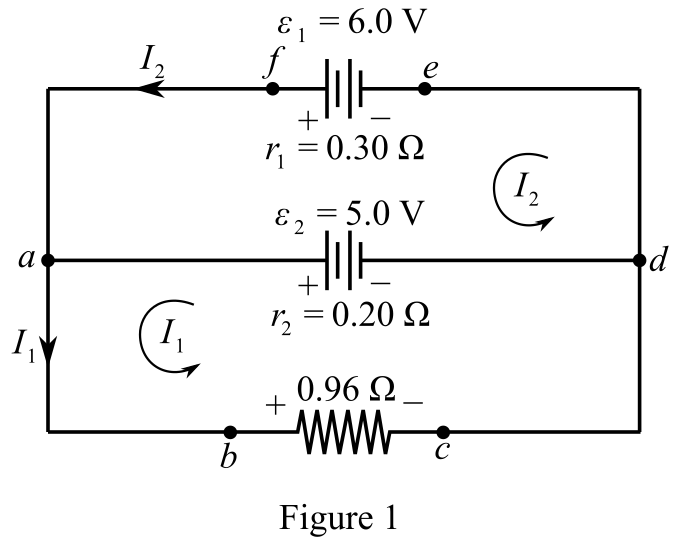
Concept explainers
For the circuit shown in Fig. 29-6, find the current in the 0.96-
![Chapter 29, Problem 7SP, 29.7 [II] For the circuit shown in Fig. 29-6, find the current in the 0.96- resistor and the](https://content.bartleby.com/tbms-images/9781259587399/Chapter-29/images/87399-29-7sp-question-digital_image47.png)
Fig. 29-6
The current in the
Answer to Problem 7SP
Solution:
Explanation of Solution
Given data:
Refer to the circuit given in Fig. 29-6.
Formula used:
Kirchhoff’s loop law: The algebraic sum of the potential change in a closed circuit is zero.
In a parallel combination, the voltage remains constant and the current is distributed. In a series combination, the current remains constant and the voltage is distributed.
Write the expression for potential difference from Ohm’s law.
Here,
Explanation:
Consider the following circuit shown in Figure 1.

Apply loop rule to the loop abcda yields, in volts.
Apply loop rule to loop adefa yields, in volts.
Solve further for
Substitute
Thus, this yields that
Therefore, the current in the
Calculate the current
Substitute
Thus, this yields that
Calculate the current flow in the branch ad in Figure 2.
The value of
Calculate the terminal voltage of the battery, whose emf is
Substitute
Thus, the terminal voltage of the battery, whose emf
Calculate the terminal voltage of the battery, whose emf is
Substitute
Thus, the terminal voltage of the battery, whose emf
Conclusion:
Therefore, the current in the
Want to see more full solutions like this?
Chapter 29 Solutions
Schaum's Outline of College Physics, Twelfth Edition (Schaum's Outlines)
- The rigid bar ABC is supported by two links, AD and BE, of uniform 37.5 × 6-mm rectangular cross section and made of a mild steel that is assumed to be elastoplastic with E = 200 GPa and σy= 250 MPa. The magnitude of the force Q applied at B is gradually increased from zero to 265 kN and a = 0.640 m. 1.7 m 1 m D A B 2.64 m E Determine the value of the normal stress in each link. The value of the normal stress in link AD is The value of the normal stress in link BE is 250 MPa. MPa.arrow_forwardTwo tempered-steel bars, each 16 in. thick, are bonded to a ½ -in. mild-steel bar. This composite bar is subjected as shown to a centric axial load of magnitude P. Both steels are elastoplastic with E= 29 × 106 psi and with yield strengths equal to 100 ksi and 50 ksi, respectively, for the tempered and mild steel. The load P is gradually increased from zero until the deformation of the bar reaches a maximum value dm = 0.04 in. and then decreased back to zero. Take L = 15 in. NOTE: This is a multi-part question. Once an answer is submitted, you will be unable to return to this part. 2.0 in. in. 3 in. 3 16 in. Determine the maximum stress in the tempered-steel bars. The maximum stress in the tempered-steel bars is ksi.arrow_forwardAmmonia enters the compressor of an industrial refrigeration plant at 2 bar, -10°C with a mass flow rate of 15 kg/min and is compressed to 12 bar, 140°C. Heat transfer from the compressor to its surroundings occurs at a rate of 6 kW. For steady-state operation, calculate, (a) the power input to the compressor, in kW, Answer (b) the entropy production rate, in kW/K, for a control volume encompassing the compressor and its immediate surroundings such that heat transfer occurs at 300 K.arrow_forward
- No chatgpt pls will upvotearrow_forwardShown to the right is a block of mass m=5.71kgm=5.71kg on a ramp that makes an angle θ=24.1∘θ=24.1∘ with the horizontal. This block is being pushed by a horizontal force, F=229NF=229N. The coefficient of kinetic friction between the two surfaces is μ=0.51μ=0.51. Enter an expression for the acceleration of the block up the ramp using variables from the problem statement together with gg for the acceleration due to gravity. a=arrow_forwardIf the density and atomic mass of copper are respectively 8.80 x 103 kg/m³ and 63.5 kg/kmol (note that 1 kmol = 1,000 mol), and copper has one free electron per copper atom, determine the following. (a) the drift speed of the electrons in a 10 gauge copper wire (2.588 mm in diameter) carrying a 13.5 A current 1.988-4 See if you can obtain an expression for the drift speed of electrons in a copper wire in terms of the current in the wire, the diameter of the wire, the molecular weight and mass density of copper, Avogadro's number, and the charge on an electron. m/s (b) the Hall voltage if a 2.68 T field is applied perpendicular to the wire 3.34e-6 x Can you start with basic equations for the electric and magnetic forces acting on the electrons moving through the wire and obtain a relationship between the magnitude of the electric and magnetic field and the drift speed of the electrons? How is the magnitude of the electric field related to the Hall voltage and the diameter of the wire? Varrow_forward
- (a) At what speed (in m/s) will a proton move in a circular path of the same radius as an electron that travels at 7.85 x 100 m/s perpendicular to the Earth's magnetic field at an altitude where the field strength is 1.20 x 10-5 T? 4.27e3 m/s (b) What would the radius (in m) of the path be if the proton had the same speed as the electron? 0.685 x m (c) What would the radius (in m) be if the proton had the same kinetic energy as the electron? 0.0084 m (d) What would the radius (in m) be if the proton had the same momentum as the electron? 0.0303 x marrow_forwardTwo charges are placed on the x axis. One of the charges (91 = +6.63 μC) is at x₁ = +3.00 cm and the other (92 = -24.2 μC) is at x2 = +9.00 cm. Find the net electric field (magnitude and direction given as a plus or minus sign) at (a) x = 0 cm and (b) x = +6.00 cm.arrow_forwardThe diagram shows the all of the forces acting on a body of mass 2.76 kg. The three forces have magnitudes F1 = 65.2 N, F2 = 21.6 N, and F3 = 77.9 N, with directions as indicted in the diagram, where θ = 49.9 degrees and φ = 21.1 degrees. The dashed lines are parallel to the x and y axes. At t = 0, the body is moving at a speed of 6.87 m/s in the positive x direction. a. whats the x component of the acceleration? b. whats the y component of the acceleration? c. whats the speed of the body in m/s at t = 12.3s? d. whats the magnitude of the displacement of the body n meters between t = 0 and 12.3s?arrow_forward
- No chatgpt pls will upvotearrow_forwardNo chatgpt pls will upvotearrow_forwardA cylinder with a piston contains 0.153 mol of nitrogen at a pressure of 1.83×105 Pa and a temperature of 290 K. The nitrogen may be treated as an ideal gas. The gas is first compressed isobarically to half its original volume. It then expands adiabatically back to its original volume, and finally it is heated isochorically to its original pressure. Part A Compute the temperature at the beginning of the adiabatic expansion. Express your answer in kelvins. ΕΠΙ ΑΣΦ T₁ = ? K Submit Request Answer Part B Compute the temperature at the end of the adiabatic expansion. Express your answer in kelvins. Π ΑΣΦ T₂ = Submit Request Answer Part C Compute the minimum pressure. Express your answer in pascals. ΕΠΙ ΑΣΦ P = Submit Request Answer ? ? K Paarrow_forward
 College PhysicsPhysicsISBN:9781938168000Author:Paul Peter Urone, Roger HinrichsPublisher:OpenStax College
College PhysicsPhysicsISBN:9781938168000Author:Paul Peter Urone, Roger HinrichsPublisher:OpenStax College Physics for Scientists and Engineers: Foundations...PhysicsISBN:9781133939146Author:Katz, Debora M.Publisher:Cengage Learning
Physics for Scientists and Engineers: Foundations...PhysicsISBN:9781133939146Author:Katz, Debora M.Publisher:Cengage Learning College PhysicsPhysicsISBN:9781305952300Author:Raymond A. Serway, Chris VuillePublisher:Cengage Learning
College PhysicsPhysicsISBN:9781305952300Author:Raymond A. Serway, Chris VuillePublisher:Cengage Learning College PhysicsPhysicsISBN:9781285737027Author:Raymond A. Serway, Chris VuillePublisher:Cengage Learning
College PhysicsPhysicsISBN:9781285737027Author:Raymond A. Serway, Chris VuillePublisher:Cengage Learning Principles of Physics: A Calculus-Based TextPhysicsISBN:9781133104261Author:Raymond A. Serway, John W. JewettPublisher:Cengage Learning
Principles of Physics: A Calculus-Based TextPhysicsISBN:9781133104261Author:Raymond A. Serway, John W. JewettPublisher:Cengage Learning Physics for Scientists and Engineers, Technology ...PhysicsISBN:9781305116399Author:Raymond A. Serway, John W. JewettPublisher:Cengage Learning
Physics for Scientists and Engineers, Technology ...PhysicsISBN:9781305116399Author:Raymond A. Serway, John W. JewettPublisher:Cengage Learning





